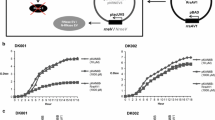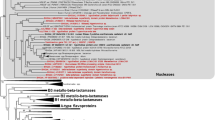Abstract
RNase E (Rne) plays a key role in the processing and degradation of RNA in Escherichia coli. In the genome of Vibrio vulnificus, one open reading frame potentially encodes a protein homologous to E. coli RNase E, designated RNase EV, which N-terminal (1-500 amino acids) has 86.4% amino acid identity to the N-terminal catalytic part of RNase E (N-Rne). Here, we report that both the full-length and the N-terminal part of RNase EV (N-RneV) functionally complement E. coli RNase E and their expression consequently supports normal growth of RNase E-depleted E. coli cells. E. coli cells expressing N-RneV showed copy numbers of ColE1-type plasmid similar to that of E. coli cells expressing N-Rne, indicating in vivo ribonucleolytic activity of N-RneV on RNA I, an antisense regulator of ColE1-type plasmid replication. In vitro cleavage assays further showed that N-RneV has cleavage activity and specificity of RNase E on RNase E-targeted sequence of RNA I (BR13). Our findings suggest that RNase E-like proteins have conserved enzymatic properties that determine substrate specificity across species.


Similar content being viewed by others
References
Carpousis AJ (2007) The RNA degradosome of Escherichia coli: an mRNA-degrading machine assembled on RNase E. Annu Rev Microbiol 61:71–87
McDowall KJ, Cohen SN (1996) The N-terminal domain of the rne gene product has RNase E activity and is non-overlapping with the arginine-rich RNA-binding motif. J Mol Biol 255:349–355
Kido M, Yamanaka K, Mitani T et al (1996) RNase E polypeptides lacking a carboxyl-terminal half suppress a mukB mutation in Escherichia coli. J Bacteriol 178:3917–3925
Ow MC, Liu Q, Kushner SR (2000) Analysis of mRNA decay and rRNA processing in Escherichia coli in the absence of RNase E-based degradosome assembly. Mol Microbiol 38:854–866
Jiang X, Belasco JG (2004) Catalytic activation of multimeric RNase E and RNase G by 5′-monophosphorylated RNA. Proc Natl Acad Sci USA 101:9211–9216
Mackie GA (1998) Ribonuclease E is a 5′-end-dependent endonuclease. Nature 395:720–724
Lee K, Cohen SN (2003) A Streptomyces coelicolor functional orthologue of Escherichia coli RNase E shows shuffling of catalytic and PNPase-binding domains. Mol Microbiol 48:349–360
Lee K, Bernstein JA, Cohen SN (2002) RNase G complementation of rne null mutation identifies functional interrelationships with RNase E in Escherichia coli. Mol Microbiol 43:1445–1456
Tamura M, Lee K, Miller CA et al (2006) RNase E maintenance of proper FtsZ/FtsA ratio required for nonfilamentous growth of Escherichia coli cells but not for colony-forming ability. J Bacteriol 188:5145–5152
Wright AC, Morris JG, Maneval DR Jr et al (1985) Cloning of the cytotoxin-hemolysin gene of Vibrio vulnificus. Infect Immun 50:922–924
Shin E, Go H, Yeom JH et al (2008) Identification of amino acid residues in the catalytic domain of RNase E essential for survival of Escherichia coli: functional analysis of DNase I subdomain. Genetics 179:1871–1879
Chang ACY, Cohen SN (1978) Construction and characterization of amplifiable multicopy DNA cloning vehicles derived from the P15A cryptic miniplasmid. J Bacteriol 134:1141–1156
Lin-Chao S, Wong TT, McDowall KJ et al (1994) Effects of nucleotide sequence on the specificity of rne-dependent and RNase E-mediated cleavages of RNA I encoded by the pBR322 plasmid. J Biol Chem 269:10797–10803
Lee K, Zhan X, Gao J et al (2003) RraA: a protein Inhibitor of RNase E activity that globally modulates RNA abundance in E. coli. Cell 114:623–634
Yeom J-H, Go H, Shin E et al (2008) Inhibitory effects of RraA and RraB on RNase E-related enzymes imply conserved functions in the regulated enzymatic cleavage of RNA. FEMS Microbiol Lett 285:10–15
Gao J, Lee K, Zhao M et al (2006) Differential modulation of E. coli mRNA abundance by inhibitory proteins that alter the composition of the degradosome. Mol Microbiol 61:394–406
Lee M, Yeom J-H, Sim S-H et al (2009) Effects of Escherichia coli RraA orthologs of Vibrio vulnificus on the ribonucleolytic activity of RNase E in vivo. Curr Microbiol 58:349–353
Acknowledgments
We thank Dr. Stanley N. Cohen for providing us with monoclonal antibodies to Rne and polyclonal antibodies to S1.
Funding
This research was supported by the Chung-Ang University Research Grants in 2010.
Author information
Authors and Affiliations
Corresponding authors
Rights and permissions
About this article
Cite this article
Lee, M., Yeom, JH., Jeon, C.O. et al. Studies on a Vibrio vulnificus Functional Ortholog of Escherichia coli RNase E Imply a Conserved Function of RNase E-like Enzymes in Bacteria. Curr Microbiol 62, 861–865 (2011). https://doi.org/10.1007/s00284-010-9771-6
Received:
Accepted:
Published:
Issue Date:
DOI: https://doi.org/10.1007/s00284-010-9771-6




